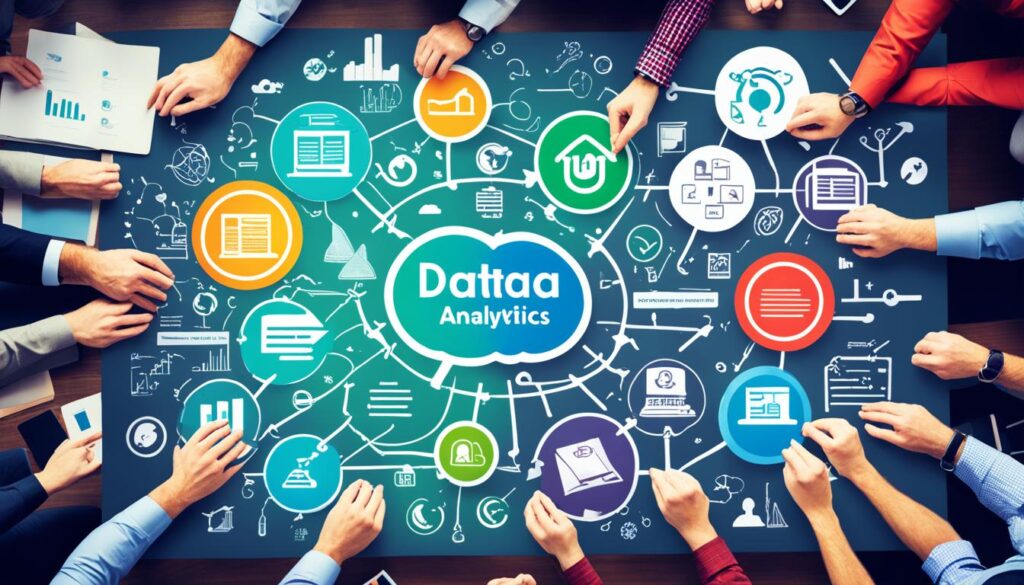Data analytics helps companies use data to make better choices and increase profits. It turns raw data into insights to grow businesses in many fields. These include manufacturing, gaming, and healthcare.
The steps of data analytics include collecting, organizing, cleaning, and analyzing data. Gathering the right data and organizing it well ensures accurate analysis. Removing duplicates and errors helps keep the findings true. This way, businesses can discover insights and make smart decisions.
There are several types of data analytics. Descriptive analytics looks at past events. Diagnostic analytics tries to understand why things happened. Predictive analytics forecasts future results. And prescriptive analytics suggests what actions to take based on the analysis.
Using data analytics can help businesses improve decisions and operations. It’s no wonder that the data analytics field is growing fast. The United States expects a 35% growth from 2022 to 2032.
So, making the most of data analytics can set your business apart. It helps make better decisions and promotes success in your industry.
Key Takeaways:
- Data analytics helps businesses optimize performance and make strategic decisions.
- The process involves data collection, organization, cleaning, and analysis.
- Various types of data analytics include descriptive, diagnostic, predictive, and prescriptive analytics.
- Data analytics is important in industries like manufacturing, gaming, content, travel, healthcare, and retail.
- Embracing data analytics can lead to better decision-making, increased profitability, and a competitive advantage.
Understanding Data Analytics
Data analytics is key for businesses to get valuable insights and improve their processes. It helps them see trends and metrics. This lets them make better choices based on data. It also helps them be more efficient and successful.
In the manufacturing sector, companies use data analytics to plan their work. They make sure their machines work at their best. By looking at how things are made, they find and fix problems. This makes things work better and saves money.
Gaming and content companies use data analytics to make things fun and personal for users. They look at how users act and what they like. This helps them create games and content that users will enjoy more.
Retailers use data analytics to understand what customers like. They look at what people buy and what they look at. This helps them recommend things that customers will want. They can also set prices better and run ads that work.
Data analytics is key for smart business moves and understanding customers. It helps in developing new products and staying competitive. By using data analytics, businesses can do well, keep up with trends, and stay strong in the market.
Steps in Data Analysis
To get the best insights from data, it’s important to follow a few steps. These help make sure the data is correctly handled. This leads to results that are dependable and correct. Let’s look at the key steps.
-
Data Requirements
First, we need to know what we want from the data. This means understanding the analysis goals. Then, we figure out what data to look at. This could be things like age, where people live, or how much money they make.
-
Collect Data
After deciding what to look at, we gather the data. It can come from many places. For example, from computer systems, the internet, or sensors. By pulling data from different sources, we get a richer dataset.
-
Organize Data
Next, we organize the collected data. It’s put into a clear structure. We group similar data together. This step makes it simpler to understand and analyze the information.
-
Clean Data
Before we start analyzing, it’s vital to clean the data. This means removing copies, fixing errors, and filling in missing details. Cleaning makes sure our analysis is based on solid information. It avoids wrong conclusions.
-
Analyze Data
With clean data, it’s time to analyze. We use tools and methods to find insights. This could uncover trends, make links between data points, or even predict the future. These insights help decision-making and shape business strategies.
By sticking to these data analysis steps, companies and groups can use data well. They can get real, useful insights and make smart choices. Doing so requires clear data needs, varied data sources, well-organized data, thorough data cleaning, and effective analysis approaches.
Types of Data Analytics
Data analytics offers many different types. They help businesses by giving meaningful insights. Descriptive analytics lets companies know what’s happened over a certain time.
Diagnostic analytics looks closely at the data inputs. It tries to find out why certain events happened. Predictive analytics uses past data to predict future results.
Lastly, prescriptive analytics looks at the data to recommend the best steps to take. Each type serves a unique role. They help businesses make smart choices.
Descriptive analytics serves as a basic analysis step. It helps businesses understand past trends. For example, a retail company uses it to check sales over a certain time. This helps them spot patterns.
Diagnostic analytics delves deeper to find the reasons for certain results. A healthcare provider might use it. They look at patient info and outcomes. This helps them improve care.
Predictive analytics uses old data to predict the future. This is how an e-commerce company might guess what customers will do. They can then adjust their marketing.
Prescriptive analytics suggests the best actions to take. A logistics company could use it. They might find better delivery routes. This saves time and fuel.
Using these analytics together, businesses can find hidden insights. They can make operations better. This leads to great results. Whether learning from the past, solving problems, anticipating trends, or deciding actions, data analysis is key for business success.
Data Analytics Tools
Data analysts use many tools for their work. These tools help in collecting, studying, and showing data. This gives analysts important clues to make better choices. Now, let’s look at some key tools they use:
Spreadsheets
 Spreadsheets like Microsoft Excel and Google Sheets are vital. They help organize data and do math. With spreadsheets, analysts can easily perform calculations and use filters. This flexibility makes them a must-have.
Spreadsheets like Microsoft Excel and Google Sheets are vital. They help organize data and do math. With spreadsheets, analysts can easily perform calculations and use filters. This flexibility makes them a must-have.
Data Visualization Software
Seeing data visually is important for making sense of it. Software such as Tableau, Power BI, and QlikView turns data into interactive charts. This makes it easier for everyone to understand and use data.
Reporting Tools
Creating reports that look good and share insights is easier with special tools. Google Data Studio, Power BI, and SAP Crystal Reports help in making professional reports. These reports show trends and important metrics to help in decision-making.
Data Mining Programs
Data mining uncovers value in big datasets. Tools like Python and R help find patterns in data. They use advanced algorithms for in-depth study and modeling.
With these tools, analysts work better and get more from their data. Spreadsheets, data visualization, reporting, and mining tools together help them achieve great business outcomes.
Importance and Benefits of Data Analytics
Data analytics is very important in today’s business world. It offers many benefits like making better decisions. By using data, companies can work better, improve their processes, and meet goals more effectively.
Data analytics is great at spotting patterns and trends. It looks at a lot of data to find important insights. These insights help companies understand what customers do, see where the market is going, and know what’s happening in their industry. This helps them stay in front of the competition.
Data analytics provides imperative information for organizations and helps stakeholders make informed decisions.
Data analytics also helps companies do their jobs better. They can look at their processes to find areas that need improvement. Making these changes can make them work more efficiently, save money, and perform better overall.
It’s also good for handling risks and finding ways to be better than their competition. By checking the data, companies can find and solve problems early, keeping them from losing money. Plus, looking at the data can show them new chances to grow and help them lead in their industries.
“Data analytics provides imperative information for organizations and helps stakeholders make informed decisions.”
Data analytics even helps make careers more secure. As more companies want to use data for decisions, people with data skills are needed. Those who are good with data analytics can find good job options in many industries.
Futhermore, it’s key for making better decisions. With the right data, companies can make smarter choices. This way, they use their resources well, focus on important things, and grab good chances with confidence.
| Benefits of Data Analytics | Enhance Operations | Better Decisions |
|---|---|---|
| Identify patterns and trends | Optimize processes | Minimize risks |
| Stay ahead of the competition | Reduce costs | Identify opportunities for growth |
| Future-proof careers | Improve overall performance | Make data-backed decisions |
To sum up, data analytics is key in the modern business world. It helps companies work better, make smarter choices, and secure a leading position. Its benefits cover many business areas, from making things work smoother to spotting chances and avoiding risks. As data use grows, data analytics becomes essential for success.
Skills Needed To Be Successful in Data Analytics
Data analytics success requires a mix of skills and qualifications. It’s all about using technical skills to work with data effectively. These skills include:
- Understanding data processes and methodologies
- Proficiency in data analytics and visualization software
- Knowledge of machine learning algorithms
- Programming languages like Python and R
Having an analytical mindset is key in this area. It means looking at data with a critical eye to spot patterns and draw insights. Problem-solving is crucial too, helping analysts tackle tough data issues.
Being detail-oriented is vital. Even small mistakes in data work can lead to big problems. Analysists must be detail-focused to ensure their findings are accurate and reliable.
Soft skills are also critical in data analytics. Good communication helps share insights clearly with others. Storytelling allows for making data into a compelling story. Time management lets analysts juggle many projects at once.
Data analytics jobs need a strong skill set. As more companies rely on data, the need for skilled professionals in technical and soft skills is growing.
Benefits of Developing Skills in Data Analytics
Learning data analytics brings many personal and professional advantages. It lets individuals:
- Extract valuable insights from data, enabling better decision-making
- Optimize business processes and workflows
- Identify and address operational inefficiencies
- Enhance the accuracy and effectiveness of forecasting
- Drive innovation and uncover new business opportunities
Mastering data interpretation is key in today’s industries. It doesn’t just open up better job opportunities. It also lets individuals contribute meaningfully to their workplace.
Skills Needed To Be Successful in Data Analytics
| Technical Skills | Soft Skills |
|---|---|
| Understanding data processes | Communication |
| Data analytics and visualization software | Storytelling |
| Machine learning algorithms | Time management |
| Programming languages (e.g., Python, R) |
Aspiring data analysts need to focus on these skills to succeed in the field.

Job Roles in the Field of Data
The world of data has many key job roles. Each role needs special skills to handle and study data well. Let’s explore some important roles in data:
-
Data Analyst
Data analysts pick apart facts to solve problems and offer recommendations. They use math and tools to find useful information in data. As a result, businesses can make smarter choices based on what trends and opportunities this data shows.
-
Data Scientist
Data scientists dive into data using math and technology. By studying big amounts of information, they find trends and make models. This helps companies plan for the future and work better. They need to know a lot about analyzing data and how to program in languages like Python.
-
Database Administrator
Database administrators look after the digital places where data lives. They make sure data is safe and easy to find. Knowing how to manage databases well is a must for this job. Skills with building and caring for databases, like using Oracle or Microsoft SQL, are key here.
-
Data Engineer
Data engineers arrange and prepare data for others to use. They build systems that help process information smoothly. Their work supports data analysts and scientists. It involves coding in languages like Python and understanding big data tools like Spark.
-
Data Architect
Data architects plan how data is managed throughout a company. They figure out how to store and find data when it’s needed. Working with others, their goal is to keep data usable and accurate. Understanding how to design and keep databases in order is crucial for this role.
The demand for these data jobs is growing fast. Companies want to use data smartly to grow and do better business. Workers in these roles are key to this success.
| Job Role | Key Responsibilities | Required Skills | Average Salary (US)* |
|---|---|---|---|
| Data Analyst | Collect, analyze, and report on data to solve problems and make recommendations. | Analytical mindset, proficiency in data analysis tools, strong communication skills. | $90,000+ |
| Data Scientist | Extract insights from data using statistical modeling, algorithms, and machine learning. | Advanced statistical and programming skills, expertise in data analysis tools, domain knowledge. | $100,000+ |
| Database Administrator | Manage and maintain databases for efficient data storage and retrieval. | Database management system expertise, problem-solving skills, attention to detail. | $90,000+ |
| Data Engineer | Organize and process data for analysis, develop data infrastructure. | Strong programming skills, knowledge of big data technologies, data pipeline development. | $100,000+ |
| Data Architect | Design and maintain the blueprint for enterprise data management. | Data modeling expertise, database design principles, data governance knowledge. | $110,000+ |
*Salary figures are approximate and may vary based on factors such as location, experience, and industry.
Conclusion
Harnessing data analytics is key for businesses today. It helps them improve their performance and achieve success. By knowing data analytics methods, using the right tools, and building skills, companies can make better choices. This leads to boosted operations and overall performance.
The amount of data is growing every day. This makes the need for data analytics experts increase quickly. Companies that use data analytics can keep up with rivals. They can also unlock the power of data. This allows them to find insights, spot trends, and innovate.
Data analytics helps businesses stand out. It makes for better experiences for customers. It also guides key decisions with data. From making processes more efficient to seeing market trends and increasing profits, data analytics is crucial. It helps businesses reach their goals.
FAQ
How can data analytics be used in my business?
Data analytics helps businesses understand trends and improve their performance. It lets you make decisions by looking at data patterns. You can use it to refine processes and make your business better.
What is the importance of data analytics?
Data analytics is key for making smart moves and spotting what customers like. It’s how you find trends, which can help with making or improving products and services. By looking at data, you get insights that change how you work for the better.
What are the steps involved in data analysis?
The process starts with knowing what data you need. Then, you gather data from different places. Next, you tidy it up to get ready for studying. Finally, you use tools and techniques to learn from the data.
What are the different types of data analytics?
There are four main types. Descriptive analytics tells you what’s been happening. Diagnostic analytics tries to find out why. Predictive analytics forecasts what might happen next. Lastly, prescriptive analytics recommends actions based on your data.
What tools are used in data analytics?
Data analysts rely on many tools. These include spreadsheets, software for visualizing data, and reporting tools. There’s also data mining software. Using these helps analyze data better and faster.
What skills are needed to be successful in data analytics?
Success in data analytics requires knowing a lot about data and tools. You need to be familiar with software and programming. But, it’s not just technical skills that matter. Thinking critically, problem-solving, and a sharp eye for detail are crucial.
What are the job roles in the field of data?
There are many roles in the data field. You could work as an analyst, a scientist, an administrator, an engineer, or an architect. Each job is vital for making sense of data and is highly sought after.
How can data analytics optimize business performance?
Data analytics boosts business by showing hidden insights. These insights can help you find patterns, improve processes, and overall, make your business stronger. It keeps you sharp, ready to compete, and make solid choices.
What are the benefits of using data analytics?
Using data analytics leads to smoother operations, smarter choices, higher productivity, and unleashes data’s full power. It’s how businesses meet their goals and keep up with tomorrow’s demands.


















